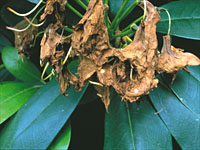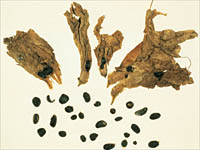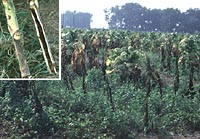Imagine you are a Georgia farmer and you have spent countless hours working to ensure you will have a great harvest at the end of the season. But one day you notice something strange in one of your fields. It appears that some of the plants are dying. Why? You contact your county Extension agent and tell him about the situation. When he visits he has no answers either, but he takes samples and sends them to the Plant Disease Clinic located at the University of Georgia so that experts at the University can look at them and performs special tests. A week later you may get your answer and the advice you need. But a week has gone by, and now it may be too late. But, how can a farmer, extension agent and Clinic specialist reduce the time it took to get a diagnosis?
 |
|
A new solution is now available to farmers in Georgia and other states: Distance Diagnostics through Digital Imaging (DDDI). DDDI was brought to farmers via the internet by the Plant Pathology Department and the Office of Information Technology at the University of Georgia, but the idea of distance diagnosis is being used or tested in other states as well. The technology is connecting farmers and extension agents to the Diagnostic Clinic and the plant diagnosticians to the field via the computer. Now answers to some questions or problems are relayed to farmers in a much shorter time.
|
 |
|
How does this new technology work? Extension offices and plant disease clinics in Georgia are equipped with an imaging station. The stations have fully integrated and specialized equipment including a handheld digital camera, stereomicroscope and compound microscopes, a video camera and the appropriate hardware and software to handle electronic imaging. County Extension agents capture images of the affected plant(s) using the handheld camera. The agent makes slides of tissues to view and then capture microscopic images of these clues, such as fungal structures, using the video camera. The images and important information about the samples are then electronically sent to the Plant Disease Clinic via the internet. Specialists review the images and communicate back to the county agent. Sometimes, a diagnosis can be made using the images and information in a matter of minutes or hours after being sent to the Clinic.

|
|
The success of this system is based with the county agents, special training and equipment because the agents can select and send the appropriate images needed for a visual diagnosis. Many plant diseases, especially those caused by bacteria and viruses, require culturing and other diagnostic tests before a conclusion can be drawn. Just as your physician has to send throat swabs or blood samples to a lab, many diseased plant samples still need to be shipped to the diagnostic lab. However, a number of plant diseases caused by fungi can be diagnosed rapidly with appropriate microscopic examination.
Has the DDDI technology benefited farmers? Yes. It has been estimated that farmers saved more than $500,000 in just the first 18 months that DDDI was in use. Now farmers can take almost immediate action against plant diseases instead of waiting a week, time that diseases can sometimes cause significantly greater losses. County Extension agents are also benefiting from the system. DDDI helps educate agents who are becoming more familiar with the diseases now that they are taking a more active role in the diagnosis. Agents also are able to make more diagnoses at their offices by using the microscopes and literature made available to them.
Georgia is not the only state using this technology; institutions outside Georgia have shown an interest in this technology and many are using this program as a model for their own programs. Internet technology and plant disease diagnostics have helped to change the way farmers can fight diseases. As technology continues to change and improve, just imagine what impacts it can have on agriculture. For more information about the University of Georgia's DDDI program, check out the website at http://www.dddi.org
|

|
Views: Black shank of tobacco.
Black shank of tobacco is a disease caused by a funguslike organism (an Oomycete) called Phytophthora parasitica var. nicotianae. Stunting and wilting are common symptoms in the early stages of black shank disease. Close examination of an infected plant often reveals a dark discoloration of one or more of the larger roots and of the interior of lower regions of stalks. Click image for an larger view, more information
|
